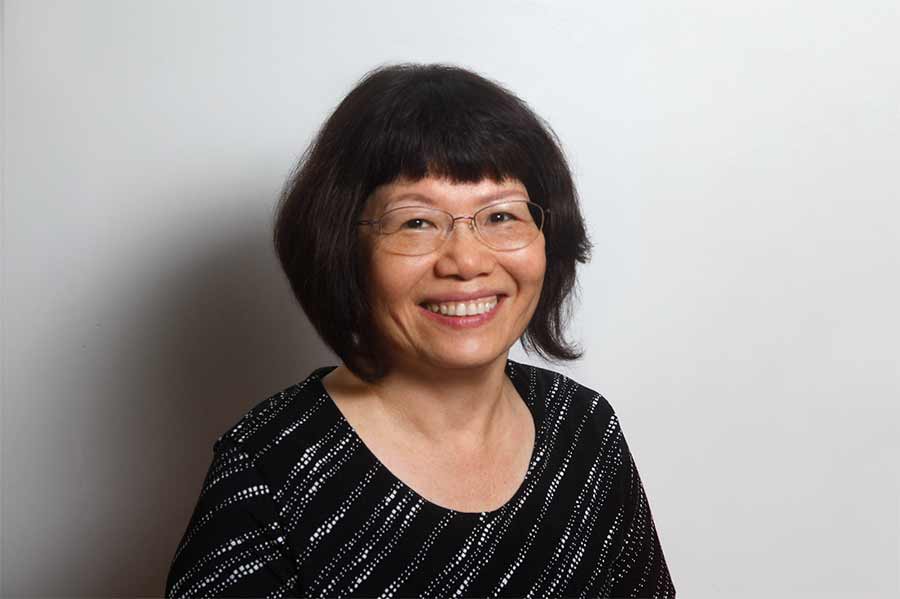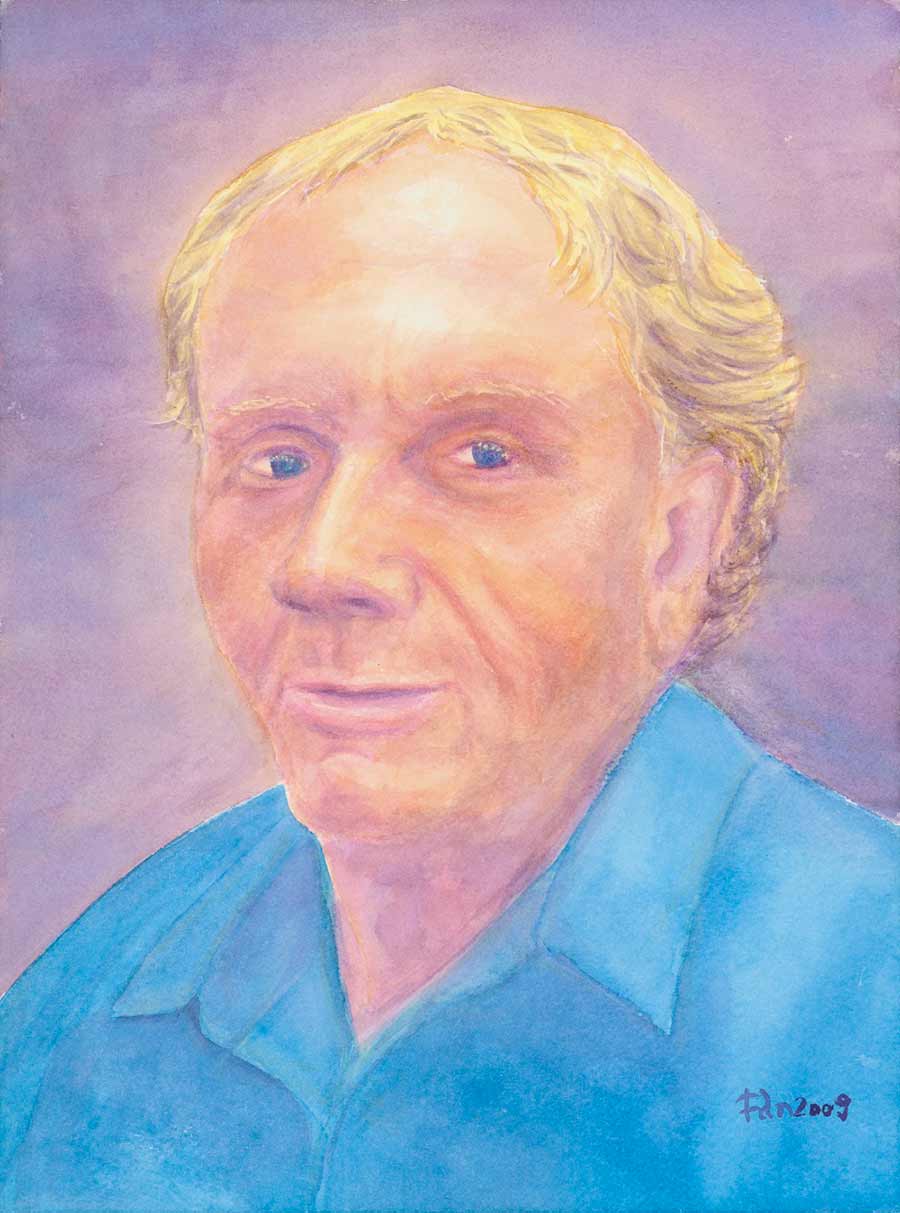
By:
- Cynthia Dillon
Published Date
By:
- Cynthia Dillon
Share This:
UC San Diego Mathematician ‘Paints by Numbers’
Emeriti professor’s medal-worthy career combines graph theory, watercolor and marriage

Fan Chung Graham
Some might say mathematicians speak their own language. But walk into at least one mathematics professor’s office at the University of California San Diego and you’ll see a whiteboard full of mind-numbing equations that look more like art than numeric symbols. Sometimes even colored markers are applied to these multinomial masterpieces spread across the whiteboard canvases.
Distinguished Professor of Mathematics Fan Chung Graham, a watercolorist as well as a professor of computer science and engineering, refers to mathematics as the language of science. “I love doing research in mathematics since it is like the pursuit of truth,” she said. “Such a process is often filled with fun and games.”
This perspective has yielded Chung Graham, a remarkable career primarily in graph theory, combinatorics and algorithmic analysis, ultimately earning her the recently announced 2017 Euler Medal from the Institute of Combinatorics and its Applications (ICA).

“Adorable Allanna” (October 18, 2012). Painting by Fan Chung Graham
Named for Leonhard Euler—a Swiss mathematician, physicist, astronomer, logician and engineer who made significant discoveries in many branches of mathematics during the 18th century—the award recognizes individuals with distinguished career contributions in an area of mathematics known as “combinatorics.” Dating back to ancient India, Arabia and Greece, the field focuses on counting, including determining the number of orders in which things can happen.
Combinatorics gained interest in the 19th and 20th centuries with the development of graph theory—the study of graphs and their properties. Highly visual with numerous applications to coding, cryptography and probability, graph theory is considered an exciting area of math. In 21st-century society, people are surrounded by innumerable connections and networks: roads and railways, phone lines and the internet, electronic circuits and social networks; even molecular bonds. These networks represent types of graphs in the world of mathematics.
“Combinatorics is about finding or avoiding patterns in sequences or graphs/networks,” explained Chung Graham, the Paul Erdös Professor of Combinatorics at UC Diego. “In this information age, mathematics is more powerful than ever for understanding massive data and networks which in turn lead to many interesting new directions.”
Her body of work ranges in specialization from spectral graph theory and extremal graphs, to the theory of quasi-randomness and the probabilistic analysis of complex networks. With nearly 300 career publications, her recent work includes local graph algorithms for complex networks and random walks-based ranking algorithms, which can be used to rank the importance of certain nodes in a network based on its structure.

Goldfish Point (July 9, 2012). Painting by Fan Chung Graham
“One of my research threads is about ranking on graphs/networks. For example, each website can be regarded as a node, and nodes are connected together by the hyperlinks forming a network,” explained Chung Graham. “The ranking of the websites mainly relies on the underlying information network.”
Her ability to weave together her research interests and the practical aspects of her life was sewn early in southern Taiwan, where she grew up. After high school, when she faced the choice of majors, her father gave her some advice: “Mathematics is the foundation of science. If you are good at math, you can do anything. You can easily switch to other areas later if needed.”
Art became one of those areas. “I paint watercolors, which is highly analytical since watercolor is usually done by many layers,” Chung Graham said of her work, which focuses on seascapes and portraits. “Each layer has to be totally dry before applying another layer. The composition of a painting is quite similar to my specialty in spectral graph theory, which extracts the structure or behavior of a graph/network by using relatively few quantities.”
She also applied math to her marriage, taking Ronald “Ron” Graham, considered one of the principal architects of discrete mathematics by the American Mathematical Society, as her husband. Ron Graham is widely respected for his work in scheduling theory, computational geometry, Ramsey theory and quasi-randomness. He serves as the chief scientist at the California Institute for Telecommunications and Information Technology (Calit2), and he was named the Irwin and Joan Jacobs Professor in Computer Science and Engineering at UC San Diego.

“The ultimate juggler: A portrait of Ronald Graham" (March 15, 2009). Painting by Fan Chung Graham.
“My husband is very fun to work with,” said Chung Graham. “We have collaborated over 90 joint papers, which are about a third of my research papers. Mathematics helps widen our communication channels, so we always have interesting topics to talk about.”
Her colleague, Lei Ni, chair and professor of the Department of Mathematics at UC San Diego, echoed the advice of Chung Graham’s father. “Mathematics has very broad applications to all areas of science and technology. The impact of combinatorics toward computer science is just one,” noted Ni. “Mathematics at UC San Diego is contributing to the transformation of the science and culture of modern days.”
Chung Graham’s advice to today’s mathematics students is: “Don’t be intimidated!”
She said that she has seen many people get discouraged because they see mathematics as full of deep incomprehensible theories.
“There is no reason to feel that way,” she encouraged. “In mathematics, whatever you learn is yours and you build it up—one step at a time. It’s not like a real-time game of winning and losing. You win if you benefit from the power, rigor and beauty of mathematics. It is a big win if you discover a new principle or solve a tough problem. Stay curious and let your life be filled with wonder.”
Chung Graham’s career distinctions include:
- the Allendoerfer Award of the Mathematical Association of America for expository excellence in 1990
- an invited plenary address at the International Congress of Mathematicians in 1994
- the Noether Lecture of the American Mathematical Society in 2009
- Membership in the American Academy of Arts and Sciences
- Fellow of the American Mathematical Society
- Fellow of the Society of Industrial and Applied Mathematics
- Academician, Academic Sinica, 2016
- Doctor of Mathematics honoris causa, University of Waterloo, 2017
The ICA is planning a formal presentation of the Euler Award to Chung Graham. “Dr. Chung has been a role model and ambassador for combinatorics throughout her distinguished career,” wrote ICA President Douglas Stinson in the award letter. “She has supervised a large number of doctoral students and has contributed to the mathematics community through extensive editorial and advisory activities.”
The Department of Mathematics at UC San Diego, part of the Division of Physical Sciences, is ranked among the top 20 graduate programs according to U.S. News and World Report.
Share This:
You May Also Like
Stay in the Know
Keep up with all the latest from UC San Diego. Subscribe to the newsletter today.


